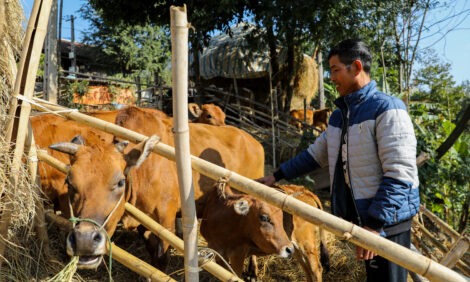



Pastured Heifers Grow Well and Have Productive First Lactations
Pastured dairy heifers in long running field trials have performed as well and better than heifer housed indoors, according to research started in 1989 by the Centre for Integrated Agricultural System.Dairy heifers that were raised on pasture in the ongoing Wisconsin Integrated Cropping Systems Trial (WICST) performed as well as or better than similar heifers that were raised in confinement. In this study, not only did heifers on managed pastures match the weights and age at first calving of their confined counterparts, but they also outperformed the confinement heifers in terms of average daily gain (ADG) during the pasture season and milk production in their first lactation.
For a summary of this story please click here
Begun in 1989, WICST is a long-term research trial managed by the UW-Madison Agronomy Department that compares three cash grain cropping systems and three forage systems in southern Wisconsin. The trial was designed to evaluate the sustainability of farming systems that differ in crop rotation complexity and use of purchased inputs. This Research Brief describes results of one WICST cropping system (CS6) that uses managed grazing with dairy heifers. Researchers collected data on this system with support from the USDA-ARS program administered through the Dairy Forage Research Center. While caution should be used in interpreting these findings, the results reported by researchers Joshua Posner and Janet Hedtcke are comparable to the favorable experiences of many farmers who raise heifers on pasture.
How the study was conducted?
In this trial, pastured heifers were grazed from May to October in groups of four to six head per year on four 0.7-acre subdivided pastures at the Arlington Research Station in Columbia County. The 500-pound heifers (about six to ten months old), which were primarily Holsteins, were randomly selected from the UW Dairy Science herd.
The Arlington pastures included red clover, smooth bromegrass, timothy and orchardgrass. Grazing pressure was adjusted throughout the season as the rate of forage growth changed. For example, in the hot, dry summer months when forage growth slowed, heifers were either given a larger area to graze or moved through the paddocks at an increased rate to maintain intake and body condition, and supplemented with hay if necessary to allow adequate pasture rest and regrowth. Rest periods for the paddocks ranged from 25 to 35 days. If pasture growth exceeded what the heifers could graze, then hay was harvested in the early season as part of the management system. Heifers were fed grain (2.5 lb/hd/day) and had free access to salt and trace minerals.
The confined heifers received a total mixed ration (TMR) that typically included 11 lbs of alfalfa haylage, 5 lbs of corn silage and 5 lbs of a corn, soybean meal, oats and molasses mixture.
Two different data sets were used for these comparisons. From 2000 to 2010, Posner and Hedtcke collected data on ADG over the grazing season for 54 heifers on pasture and 61 confinement heifers. The UW Dairy Science Department subsequently collected first lactation performance data from 2000 to 2009 for 37 of the pastured heifers and 48 of the confinement heifers (fewer animals were included in the second set of data because some animals were sold before the data was collected). The data on the first lactation included milk yield, health issues and age at first calving for heifers when they entered the confinement milking string at Arlington.
February 2013
Further ReadingYou can view the full report by clicking here. |


